
Giovanni Bellini was an Italian Renaissance painter, probably the best known of the Bellini family of Venetian painters. He was raised in the household of Jacopo Bellini, formerly thought to have been his father, but now that familial generational relationship is questioned. An older brother, Gentile Bellini was more highly regarded than Giovanni during his lifetime, but the reverse is true today. His brother-in-law was Andrea Mantegna.

The Basilica di Santa Maria Gloriosa dei Frari, commonly abbreviated to the Frari, is a church located in the Campo dei Frari at the heart of the San Polo district of Venice, Italy. It is the largest church in the city and it has the status of a minor basilica. The church is dedicated to the Assumption of Mary.
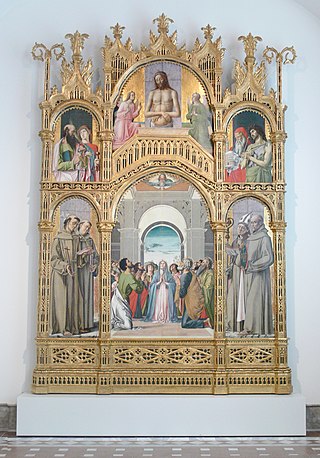
Alvise or Luigi Vivarini (1442/1453–1503/1505) was an Italian painter, the leading Venetian artist before Giovanni Bellini. Like Bellini, he was part of a dynasty of painters. His father was Antonio Vivarini and his uncle, with whom he may have trained, was Bartolomeo Vivarini. Another uncle, on his mother's side, was the artist known as Giovanni d'Alemagna, who worked with his brother-in-law Antonio. Alvise may have trained Jacopo de' Barbari.

The Assumption of the Virgin or Frari Assumption, popularly known as the Assunta, is a large altarpiece panel painting in oils by the Italian Renaissance artist Titian, painted in 1515–1518. It remains in the position it was designed for, on the high altar of the Basilica di Santa Maria Gloriosa dei Frari or Frari church in Venice. It is the largest altarpiece in the city, with the figures well over life-size, necessitated by the large church, with a considerable distance between the altar and the congregation. The images above and below are not Titian's work, they are by Palma Vecchio. It marked a new direction in Titian's style, that reflected his awareness of the developments in High Renaissance painting further south, in Florence and Rome, by artists including Raphael and Michelangelo. The agitated figures of the Apostles marked a break with the usual meditative stillness of saints in Venetian painting, in the tradition of Giovanni Bellini and others.

The San Zeno Altarpiece is a polytych altarpiece by the Italian Renaissance painter Andrea Mantegna created around 1456–1459. It remains in situ in the Basilica di San Zeno, the main church of the Northern Italian city of Verona. Mantegna's style mixes Greco-Roman classical themes along with Christian subjects in this altarpiece. The central panel, along with the three paintings that comprise the predella, were taken in 1797 by the French. While the main, central scene was returned by the French to Verona in 1815, the three predella paintings in Verona today are copies, since the original ones remain in France at the Louvre (Crucifixion) and in the Musée des Beaux-Arts in Tours. The paintings are made with tempera on panel; not oil as mistakenly identified in one source.

The Madonna dell'Orto is a church in Venice, Italy, in the sestiere of Cannaregio.
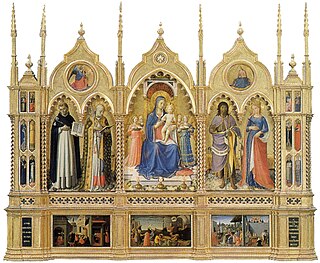
The Perugia Altarpiece is a painting by the Italian early Renaissance painter Fra Angelico, housed in the Galleria Nazionale dell'Umbria of Perugia, Italy.
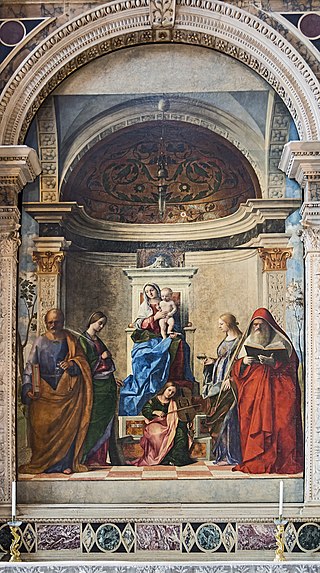
The San Zaccaria Altarpiece is a painting by the Italian Renaissance painter Giovanni Bellini, executed in 1505 and located in the church of San Zaccaria, Venice.

The San Giobbe Altarpiece is a c. 1487 oil painting by the Italian Renaissance master Giovanni Bellini. Inspired by a plague outbreak in 1485, this sacra conversazione painting is unique in that it was designed in situ with the surrounding architecture of the church, and was one of the largest sacra conversazione paintings at the time. Although it was originally located in the Church of San Giobbe, Venice, it is now housed in the Gallerie dell'Accademia in Venice after having been stolen by Napoleon Bonaparte.

The St John Altarpiece is a large oil-on-oak hinged-triptych altarpiece completed around 1479 by the Early Netherlandish master painter Hans Memling. It was commissioned in the mid-1470s in Bruges for the Old St. John's Hospital (Sint-Janshospitaal) during the building of a new apse. It is signed and dated 1479 on the original frame – its date of installation – and is today still at the hospital in the Memling museum.

The Pesaro Altarpiece is an oil on panel painting by Giovanni Bellini, dated to some time between 1471 and 1483. It is considered one of Bellini's first mature works, though there are doubts on its dating and on who commissioned it. The work's technique is not only an early use of oils but also of blue smalt, a by-product of the glass industry. It had already been used in the Low Countries in Bouts' 1455 The Entombment, but this marked smalt's first use in Italian art, twenty years before Leonardo da Vinci used it in Ludovico il Moro's apartments in Milan in 1492. Bellini also uses the more traditional lapis lazuli and azurite for other blues in the work.
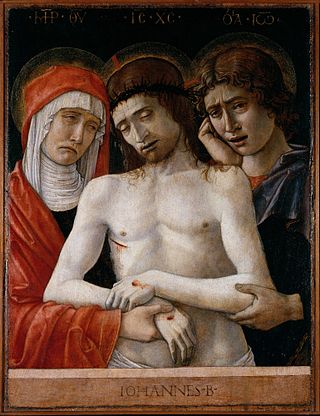
The Pietà or Christ's Body Supported by the Virgin Mary and St John the Evangelist is a tempera on panel painting by Giovanni Bellini, now in the Accademia Carrara in Bergamo. Dated to around 1455, it is one of his earliest independent works and the prototype for his series of pietàs. It draws on Byzantine icons of the 'imago pietatis', of which there were many examples throughout Venice, and of 'Ritratti di Passione' or 'portraits of the Passion', in which the dead Christ invites the viewer to contemplate his wounds. The crossed arms are drawn from a famous Roman mosaic-icon from Santa Croce in Gerusalemme basilica which was held to be miraculous and had according to legend been commissioned by pope Gregory the Great based on a vision during a mass.

The Barbarigo Altarpiece or Enthroned Madonna and Child with Angel Musicians and Saint Mark, Saint Augustine and Doge Agostino Barbarigo is a 1488 oil painting on panel by Giovanni Bellini, now in the church of San Pietro Martire in Murano.

The San Sebastiano Triptych is a 1464–1470 tempera on panel altarpiece by Giovanni Bellini and others. Its central panel of saint Sebastian measures 127 by 48 cm, its lunette of God the Father and the Annunciation 59 by 170 cm and its side panels of John the Baptist and Antony the Great 103 by 45 cm. It is now in the Gallerie dell'Accademia in Venice.
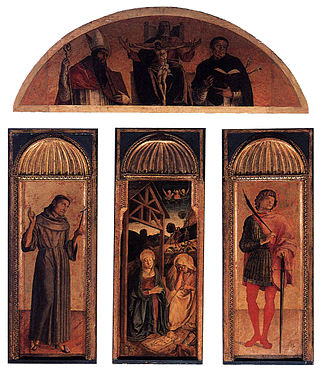
The Nativity Triptych is a 1464–1470 tempera on panel altarpiece by Giovanni Bellini and others. Its central panel of the Nativity measures 127 by 48 cm, its lunette of the Holy Trinity flanked by Augustine and Dominic 59 by 170 cm and its side panels of Francis of Assisi and Victor 103 by 45 cm. It is housed in the Gallerie dell'Accademia in Venice.

The San Lorenzo Triptych is a tempera on panel altarpiece by Giovanni Bellini and others. Its central panel of Saint Lawrence measures 127 by 48 cm, its lunette of the Madonna and Child 59 by 170 cm and its side panels of John the Baptist and Antony of Padua 103 by 45 cm each. It is now in the Gallerie dell'Accademia in Venice.

The Triptych of the Madonna is a 1464–1470 tempera on panel altarpiece by Giovanni Bellini and others. Its central panel of a standing Madonna and Child measures 127 by 48 cm, its lunette of the Man of Sorrows flanked by angels 59 by 170 cm and its side panels of Jerome and Louis of Toulouse 103 by 45 cm. It is now in the Gallerie dell'Accademia in Venice.
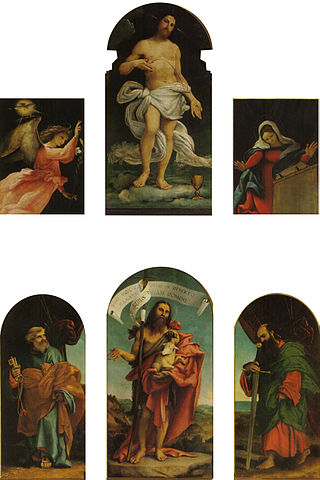
The Ponteranica Altarpiece is a six-panel oil painting series produced by Lorenzo Lotto in 1522, commissioned by the Scuola del Corpo di Cristo for the parish church of San Vincenzo e Sant'Alessandro in Ponteranica, where it still remains. Its upper register shows the risen Christ flanked by an Annunciation scene, whilst below is John the Baptist flanked by saints Peter and Paul.

The Mosaic ceiling of the Florence Baptistery is a set of mosaics covering the internal dome and apses of the Baptistery of Florence. It is one of the most important cycles of medieval Italian mosaics, created between 1225 and around 1330 using designs by major Florentine painters such as Cimabue, Coppo di Marcovaldo, Meliore and the Master of the Magdalen, probably by mosaicists from Venice.























